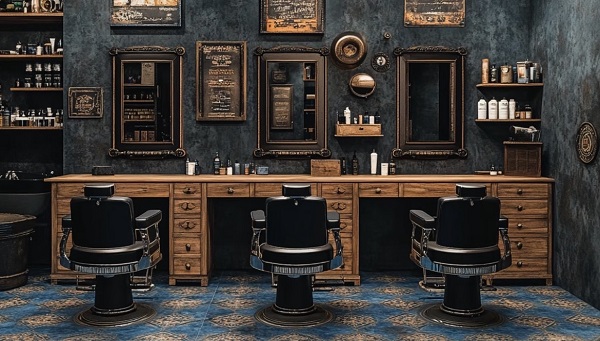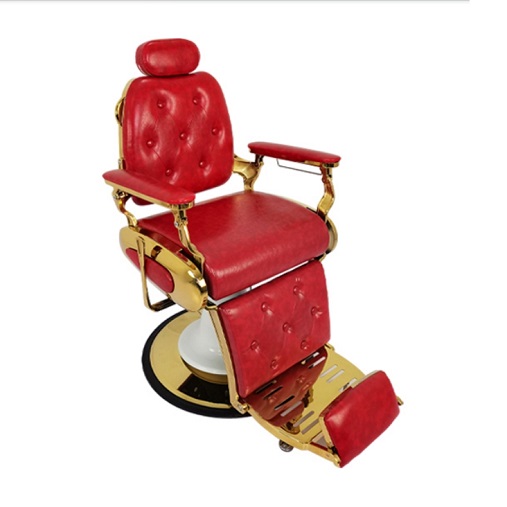Walk into any barbershop, and you’ll notice one piece of equipment that gets more use than anything else: the barber chair. It’s where every service begins and ends. Clients spend the majority of their time in that seat, and the comfort, stability, and appearance of the chair leave a lasting impression—whether good or bad.
Because barber chairs are in near-constant use, they face daily wear from shifting clients, chemical exposure, and repetitive mechanical adjustments. Over time, this can lead to issues like hydraulic malfunctions, upholstery damage, or loose components. None of these problems happen overnight, but once they appear, they can interrupt your workflow and cost you money in repairs or replacements.
The good news is that most problems can be prevented with consistent upkeep. A solid maintenance routine not only extends the life of your chairs but also helps preserve their appearance and performance. In a busy shop, taking ten extra minutes a day for cleaning and quick inspections can save hundreds—or even thousands—of dollars in the long run.
Below, we’ll go through practical, easy-to-implement tips for keeping your barber chairs in top condition, followed by a look at several high-quality chairs from Dongpin that combine durability with easy maintenance.

Practical Maintenance Tips for Barber Chairs
Keeping your barber chairs in peak condition isn’t about complicated repairs—it’s about consistent, simple habits. The following steps are easy to integrate into your shop’s routine and will make a big difference over time.
1. End-of-Day Cleaning
Remove loose hair and residue: Use a handheld brush or vacuum to clear hair from the seat, backrest, armrests, and footrest. Hair tends to work its way into seams and under cushions, so check those areas carefully.
Use the right cleaning products: For leather or PU surfaces, a damp cloth and mild cleaner will handle daily grime. Avoid harsh chemicals, which can dry and crack upholstery.
For fabric-covered areas: Vacuum thoroughly and spot-clean with an upholstery-safe solution. Steam cleaning can help loosen dirt without soaking the material.
2. Protect Against Chemical Damage
Use barriers during services: When coloring, bleaching, or perming, place a protective cape or disposable sheet over the chair to prevent staining.
Mind your spray zone: Hairsprays, disinfectants, and cleaning sprays can leave residue or discolor upholstery. Cover the chair or spray products away from it.
3. Weekly Hardware Inspection
Check fasteners: Once a week, inspect screws, bolts, and nuts on the base, armrests, footrests, and backrest. These can loosen with daily use, especially in high-traffic shops.
Tighten as needed: Use the proper tools to secure loose parts and prevent wobbling, squeaking, or uneven movements.
4. Care for the Hydraulic System
Watch for performance changes: If the chair is lifting slowly, sinking unexpectedly, or feels unstable, check the hydraulic oil level and top it up if necessary.
Inspect for leaks: Look around the base for signs of oil—leaks mean the seals may need replacement. Addressing this early prevents larger failures.
5. Lubricate Moving Parts
Schedule lubrication: Every 3–6 months, apply a light, non-staining lubricant to moving joints, tilt mechanisms, and swivel points.
Keep it clean: Wipe away excess oil to avoid attracting dust or staining clothing.
6. Use the Chair Properly
Respect weight limits: Check the manufacturer’s recommended maximum weight capacity and stick to it to avoid frame or hydraulic damage.
Gentle entry and exit: Ask clients to avoid dropping into the seat or leaning heavily on armrests when standing up.
7. Quarterly Deep Cleaning
Go beyond the surface: Every few months, remove cushions if possible, clean underneath, and wipe down the hydraulic pole and base.
Condition and protect: Apply leather conditioner to keep upholstery supple and rust inhibitor on metal parts to prevent corrosion.
8. Fix Problems Early
Don’t wait until it’s serious: A chair that squeaks, wobbles, or resists reclining is telling you something. Small repairs now will save you the cost and downtime of major repairs later.
IV. Dongpin Barber Chair Recommendations
Choosing a chair that’s built to last makes maintenance much easier. Dongpin offers a range of barber chairs designed with both durability and user comfort in mind. Here are four models worth noting, each with features that suit different shop environments.
1. Black Barber Chair 2074
Style and versatility: The 2074’s sleek black finish and clean, modern profile make it an easy fit for contemporary barbershops.
Low-maintenance materials: The PU leather upholstery resists stains and is quick to wipe down, which is ideal for busy shops with back-to-back clients.
Stable hydraulic system: Built for smooth, consistent height adjustments, this chair’s hydraulic base requires minimal upkeep beyond regular cleaning and occasional lubrication.

2. Professional Reclining Barber Chair DP-028
Designed for multi-service use: The DP-028 reclines fully, making it a good fit for barbershops that also offer hot towel shaves, facial treatments, or eyebrow services.
Comfort-driven design: A wide seat, thick cushioning, and adjustable headrest keep clients comfortable for longer services.
Easy-to-clean upholstery: The smooth PU surface resists staining from shaving cream, beard oils, and other products, reducing maintenance time.
3. XF-105 Vintage Barber Chair
A statement piece: With its polished metal frame, intricate stitching, and vintage-inspired silhouette, the XF-105 is as much a design feature as it is a functional chair.
Durable build: Heavy-duty metal components stand up well to high client volume, and regular rust-prevention treatment keeps the finish looking sharp.
Perfect for themed spaces: Whether your shop leans toward retro, industrial, or classic, this chair adds character without sacrificing performance.

4. 8827 Heavy-Duty Barber Chair
Strength and stability: Designed with a reinforced frame and a wide base, the 226 handles larger clients with ease while staying steady during use.
Smooth adjustments: Reclining, swiveling, and height changes operate without jerks or sticking, reducing mechanical stress over time.
Low-maintenance advantage: The structure and materials are built for long service life, with minimal need for frequent repairs.
FAQ — Common Barber Chair Maintenance Questions
Q1. Barber chair hydraulic not rising — what should I do?
A1: If your barber chair’s hydraulic pump won’t lift, check for low oil levels and inspect for visible leaks. Sometimes, air can get trapped in the system; cycling the pump a few times may help. If these steps don’t resolve the problem, the seals or pump mechanism may need professional servicing.
Q2. Barber chair slowly sinking — why does it happen?
A2: A chair that sinks on its own usually has a worn or damaged hydraulic seal, allowing oil to bypass the piston. This can also be caused by internal wear in the pump. Replacing the faulty seal or pump parts will typically restore proper function.
Q3. How to lubricate barber chair hydraulic pump?
A3: Locate the moving joints and pivot points around the hydraulic base and reclining mechanism. Use a non-staining lubricant suitable for metal-to-metal contact. Avoid over-lubricating—wipe away any excess to prevent attracting dust or staining upholstery.
Q4. Barber chair squeaky or loose — what should I check?
A4: Start by tightening all screws and bolts on the base, armrests, footrests, and backrest. If the noise persists, check for worn bushings or misaligned components. Lubricating metal contact points often resolves squeaks caused by friction.
Q5. Barber chair professional servicing — how often is it needed?
A5: For high-volume shops, an annual professional inspection is recommended. This includes checking the hydraulic pump, lubricating internal parts, replacing worn seals, and ensuring all fasteners are secure. Lower-traffic shops may be able to extend this to every 18 months.
"*" indicates required fields